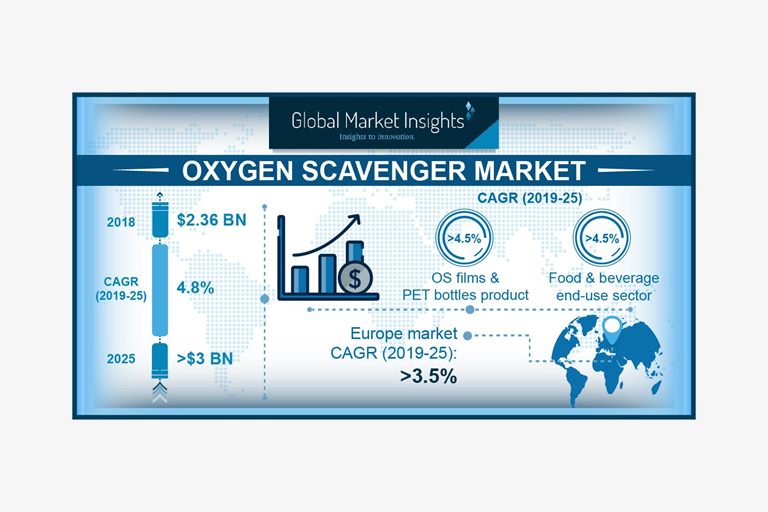The oxygen scavengers market size is primarily driven by the increasing demand from food & beverage industry for packaging applications. Small traces of oxygen left in food packaging can nurture breeding grounds for microorganisms as they flourish in the presence of oxygen and keep feeding on the food items at the same time, leading toward food spoilage.
Increasing usage to remove oxygen from industrial boilers will drive oxygen scavengers market trends as well. Maintaining optimum boiler efficiency is very crucial for the industries leveraging the hot water and steam for different processes. If feed water consists of dissolved oxygen it can creates serious issues by damaging boiler components leading toward boiler breakdowns. Consistent exposure to oxygen causes rusting of metal, deteriorating the component quality and life.
Incorporation of oxygen scavengers effectively removes the dissolved oxygen in the water and thus helps to maintain desired operational efficiency throughout the industrial processes. Growing emphasis on reducing repair & maintenance costs by taking essential precautionary measures has become a standard among the industries. Robust industrialization along with significant increase in the number of manufacturing units will facilitate the adoption of boilers, further boosting product consumption.
According to research report by Global Market Insights, Inc., Oxygen Scavengers Market size is projected to grow over USD 3 billion by 2025.
How will F&B sector emerge as a crucial avenue for oxygen scavengers market
Even if microorganisms do not turn the food rancid completely, they can cause other impact such as loss of nutrition, changes in texture, lipid oxidation, and compromised flavor and aroma of the packaged food & beverages. Hence, oxygen scavengers are immensely deployed in the food & beverage industry to counter these microbial issues.
The product plays a pivotal role in lengthening the lifespan packaged food and thus ensuring safety. Growing proliferation of ready-to-eat or ready-to-cook processed, and packaged food will drive the oxygen scavengers market growth. Rapidly changing urban lifestyle, busy work schedules and increasing spending power of people will drive demand for packaged foods, subsequently boosting the oxygen scavenger market trends in upcoming years.
Estimates claim that oxygen scavengers market size from food & beverage end-use sector will depict a CAGR of over 4.5% through 2025.
How will pharmaceutical end-user segment perform in the oxygen scavengers market
Oxidative degradation is one of the major issues faced by many medicine manufacturers. Implementation of the product stops arrests oxygen permeation through packaging and thus helps maintaining the efficacy of pharmaceutical products for longer durations. With significant increase in shelf life, it also aids in cost optimization during distribution & sales by allowing to store medicines for longer time ensuring overall profitability.
Increasing investments in the pharmaceutical sector to support consistent R&Ds to enhance drug life and efficacy will indirectly accelerate the pharmaceutical packaging sector in near future, eventually boosting the market share during the forecast period.
North America is estimated to reach about 25% of the global oxygen scavenger market share by volume before 2025. The growth can be attributed to rapidly developing pharmaceutical sector in the region along with ongoing research and development activities. Rising government investments to boost pharmaceutical production in upcoming years will drive the regional share.
How will the Asia Pacific oxygen scavengers market fare over the forecast period
Asia Pacific will emerge as promising region for oxygen scavengers market growth owing to industrial revolution promoted by local governments. The product is deployed in large number of end-use industries. The surging demand from the proliferating food & beverage industry in particular, will drive the regional trends. Moreover, the presence of prominent pharmaceutical players will also support the market growth.


















